Summary of I. M. Pei
The Chinese-American I. M. Pei, is one of this century's most venerated architects. In a career spanning six decades, he became universally admired for his skill in designing striking modern buildings and complexes that retained a keen sense of regional individuality. He is responsible for the creation of some of the world's most iconic structures - not least the Louvre Pyramid in Paris, the Bank of China Tower in Hong Kong, and the Museum of Islamic Art in Doha - but his portfolio is vast, covering arts facilities, university buildings, civic centers, libraries, and hotels. The recipient of numerous international prizes and awards, the jury citation for perhaps the most prestigious of all, the Pritzker Prize (in 1983), summed up Pei's architecture as being "characterized by its faith in modernism [and] humanized by its subtlety, lyricism, and beauty".
Accomplishments
- Perhaps Pei's most iconic structure remains his glass and steel Louvre Pyramid which, in the late 20th century, simultaneously revitalized Paris's Louvre Palace, and confirmed the French capital's reputation for innovation in modern architecture. Pei's entrance hub to the world's most visited art museum, which sees visitors travel through the Pyramid doors, down into an underground intersection of galleries that connects to the museum's main buildings, has become Pei's "statement" design.
- Pei was greatly inspired by Cubism and took inspiration from the works of Pablo Picasso, Georges Braque, and Juan Gris. His skillful cuboid designs, most pronounced in the National Center for Atmospheric Research (Colorado), the Everson Museum (Syracuse), and the National Gallery's East Building (Washington DC), explored how exterior and interior spaces are brought to life by the balance of solids and voids, and the how the effects of natural light, accentuate these dynamics.
- Pei's East Wing of the National Gallery of Art in Washington DC is considered a masterpiece of geometric precision. Conceived of as two triangles, it includes the key elements of Pei's design - the harmonizing of mass, volume, light, and materials. The East Wing's exterior harmonizes beautifully with the original gallery building (opened 37 years earlier) with marble sourced from the same Texas quarry. At the time of its completion, Pei cited the East Wing as his most accomplished work.
- Pei is associated with the streamlined beauty of the International Style, so called because its spacious interiors, simple lines, and strict geometric forms, breached national, cultural (and political) borders. Yet Pei strongly advocated for contextual and regional variations to influence this High Modernist style. On a trip to his homeland in China in 1974, for instance, he appealed to architectural students to individualize their designs by embracing Chinese heritage rather than adhere slavishly to a style that, in 20th century China, was largely based on modernist Soviet designs.
The Life of I. M. Pei
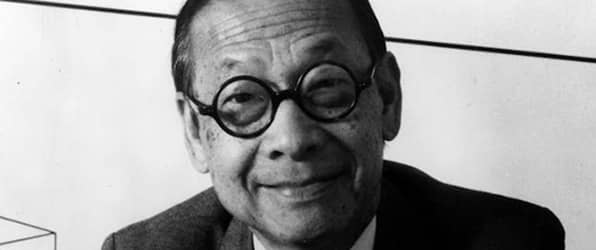
Architecture professor Andrew Scott referred to Pei as "a master-architect with a deep understanding and sophistication with issues of urbanism, scale of object and detail, spatial orchestration, and formal composition".
Important Art by I. M. Pei
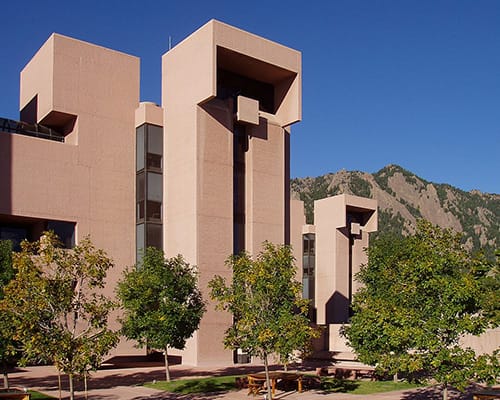
Mesa Laboratory
In 1961, Pei was approached by astronomer Walter Orr Roberts, founder of the National Center for Atmospheric Research (NCAR), to design the center's new Mesa Laboratory. The building's site was very unlike the urban projects Pei was used to, lying as it does in the foothills of the Rocky Mountains, on the Table Mesa below the Flatirons' sandstone cliffs. In the early design stages, Pei spent much time driving around the region, surveying the natural surroundings, with a vision of designing a building that would complement the surrounding environment. He later explained "I recalled the places I had seen with my mother when I was a little boy - the mountaintop Buddhist retreats. There in the Colorado mountains, I tried to listen to the silence again - just as my mother had taught me. The investigation of the place became a kind of religious experience for me". At the same time, he researched the way in which the Anasazi (or Ancestral Puebloans) built their Mesa Verde cliff dwellings in harmony with their environment.
Following discussions with Roberts, who dismissed Pei's original designs as "just a bunch of towers", the two men agreed on a dispersed series of clustered building, joined by lower buildings and two underground levels, with walkways conscientiously arranged almost like mazes, to increase the chance of casual encounters amongst employees at the site. Pei explained that his design was strongly influenced by Cubist design principles (such as those he admired in the paintings of Picasso, Braque, and Gris). For the exterior of the laboratory complex, he settled on a bush-hammered concrete process (common to the area), which, with local red sandstone aggregates mixed in, would make the complex look "as if it were carved out of the mountain". Architecture journalist Nick Mafi notes that the "integration of nature and landscape into his designs" would continue to be a hallmark of Pei's work. Indeed, the Mesa Laboratory was one of his favorite projects to work on, and one that brought him considerable pride.
The Mesa Laboratory has won many honors. In 1967 it was named the "Laboratory of the Year" by Industrial Research Magazine, and, in 1997, won the American Institute of Architects: Colorado Chapter's 25 Year Award (given for buildings that continue to serve their original function and have withstood the "test of time" over a 25- to 35-year period"). As recently as 2007, it was named "Best Research Center" by Go! magazine. It has also featured as a setting in science-fiction films including the Woody Allen comedy, Sleeper (1973), David Twohy's The Arrival (1996), as well as the 2017 post-apocalyptic video game Horizon Zero Dawn.
Boulder, Colorado
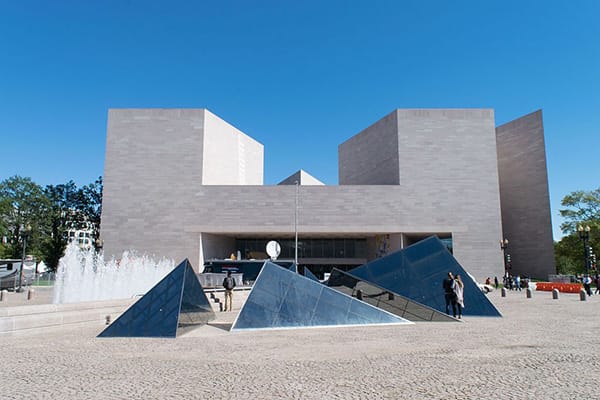
National Gallery East Building
In the mid-1960s, Pei was commissioned to design a new building for the National Gallery in Washington DC, to sit just to the east of the existing building, and to house both exhibition spaces and offices/archives. The building committee selected Pei's design (which he initially sketched on the back of an envelope during a flight from Washington, DC, to New York) based on what they had seen in his previous projects at the Des Moines Art Center in Iowa, and the Johnson Museum at Cornell University in Ithaca, New York. The site for the proposed building was an awkward trapezoid shape, which Pei accommodated by designing a building comprised of two triangles (one for each primary function of the building), one larger isosceles and one smaller right-angled, with a spacious lobby with large skylights, allowing natural light to flood the space in the center. Pei's aspirations for the lobby were for it to enthrall visitors in much the same way as the central room as the Guggenheim Museum, New York City. For the building's exterior to match seamlessly with the exterior of the original gallery building (designed by John Russell Pope and built in 1941), Pei had marble sourced from the same quarry (in Knoxville, Tennessee) and even hired the quarry supervisor from the original project.
The National Gallery East Building was named one of America's Ten Best Buildings by the American Institute of Architects (AIA) in 1986 and later, in 2004, given the AIA's 25 Year Award. Pei considered it to be one of his most important works, once stating, "it was not until the National Gallery that I felt I had found a conviction about what architecture meant". While some disliked the East Building, Artforum critic Richard Hennessy, for instance, disparaged its "shocking fun-house atmosphere" and its "aura of ancient Roman patronage", it was generally well-received, with New York Times critic Ada Louise Huxtable calling it "a palatial statement of the creative accommodation of contemporary art and architecture".
More recently, architectural critic Paul Goldberger has argued that with this project, Pei "had the opportunity to demonstrate his belief that modernism was capable of producing buildings with the gravitas, the sense of permanence and the popular appeal of the greatest traditional structures. [...] Mr. Pei, many critics said, had found a way to get beyond both the casual, temporal air and the coldness of much modern architecture, and to create a building that was both boldly monumental and warmly inviting, even exhilarating". Architecture critic James Gardner has called the East Building "perhaps [Pei's] most prominent achievement in the United States" adding that "combining brutalist drama and flawless geometric refinement on the exterior, Pei conceived for this project one of the most intricate and evocative interiors of any American museum".
Washington, DC
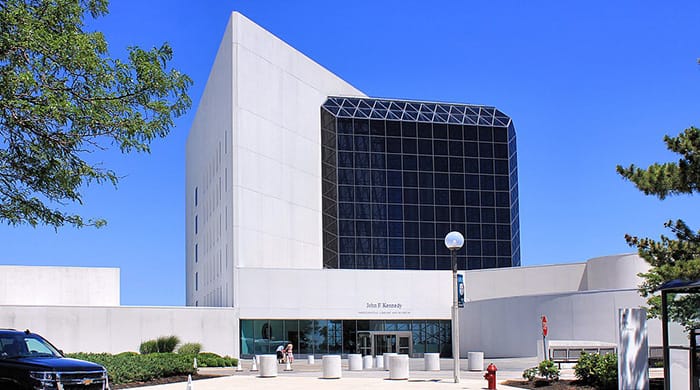
John F. Kennedy Presidential Library and Museum
The memorial library to President John F. Kennedy was considered by Pei to be among his most prestigious commissions. After much deliberation, Kennedy's widow, Jacqueline Kennedy Onassis, selected Pei over more established architects, Louis I. Kahn and Mies van der Rohe. Based on his previous projects, she felt that Pie "didn't seem to have just one way to solve a problem. He seemed to approach each commission thinking only of it and then develop a way to make something beautiful". She said of Pei "[he] was so full of promise, like Jack [John Kennedy's nickname]; they were born in the same year. I decided it would be fun to take a great leap with him". The complex project was to home, not just ample library space, but also an archive, museum, and political science institute.
There was a significant amount of toing-and-froing during the design process, with Pei's original plan (at the first proposed site in Cambridge, Massachusetts) for a large glass pyramid rejected (consulted members of the public feared the design would become a "tourist attraction" that would appear gaudy next to the more traditional American colonial architecture found in the nearby Harvard Square). Eventually, the project was moved to Boston, to a "less-than-desirable" 10-acre site at Columbia Point, near the University of Massachusetts Boston, atop a landfill and a large sewage pipe (all of which had to be covered using beach grass, a nod toward President Kennedy's love of the sea and with ventilation systems installed to divert objectionable odors). The new building design was, as architecture journalist Dan Howarth puts it, "an austere block intersected at an angle by a glass atrium, with lower portions surrounding the main volumes".
Architecture critic Steve Rose stated that, "[as with the National Gallery East Building] Pei never shied away from a good contrast. [What] appears to be jarring proves to be respectful, practical and mindful of its site". Architecture journalist Paul Keskeys called the Kennedy Presidential Library a "striking form [...] that became an instant icon for Boston", while the library's director, Alan Price, added that the building "reflects the extent to which Pei was inspired by Kennedy. The grand space of the pavilion, with its large flag, is extraordinary and timeless. You can't help but lift your head up, see the flag, and experience the awesomeness of what was and what might have been".
Boston, Massachusetts
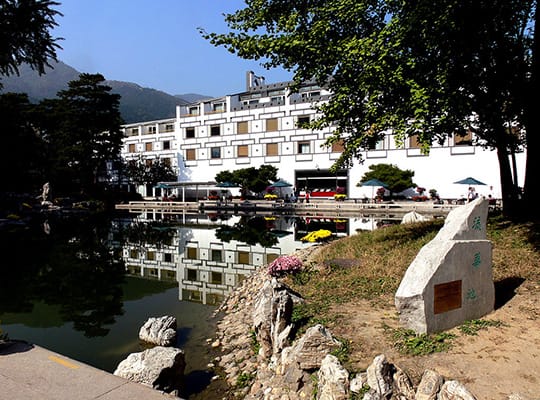
Fragrant Hill
In 1974, at a moment when there was a significant increase in cultural exchanges between the United States and China (following President Richard Nixon's 1972 visit, which marked a major milestone in harmonizing relationships between the two countries), Pei had the opportunity to return to his homeland for the first time in nearly 40 years as part of a cultural exchange tour organized by the American Institute of Architects (AIA). The Chinese government invited Pei to design a series of high-rise hotels in the center of Beijing. Pei declined, as he "feared such buildings would deface the city". By way of a concession, the government offered him the opportunity to design a resort hotel in a rural area outside the city. The resultant project, which featured a large central four-story atrium roofed with glass panels, was called Fragrant Hill and was designed to complement its woodland surroundings. Goldberger described Fragrant Hill as "a sprawling building in which [Pei] tried to combine the geometric modernism of his other buildings with elements from traditional Chinese architecture". The public, however, largely criticized his return to a Chinese tradition. As Pei put it, "many people thought I was being reactionary".
Pei was mostly disappointed by the outcome of the project, as he felt it was not well-constructed and, as he learned from some of his staff who visited the site a few years later, it had been poorly maintained and fallen into disrepair (which Pei attributed to the Chinese authorities being generally unfamiliar with managing deluxe buildings). The only redeeming quality for Pei was its woodland setting; as he put it in a 2006 interview, the hotel, "was saved by the trees". For all Pei's reservations, Goldberger notes, Fragrant Hill was significant as the first of his attempts "to acknowledge the growing interest of many architects in reusing historical form; in a similar vein, he would later design a high-rise hotel in Midtown Manhattan, the Regent (now the Four Seasons), which tried to evoke the romantic, stepped-back forms of prewar New York skyscrapers".
Beijing, China
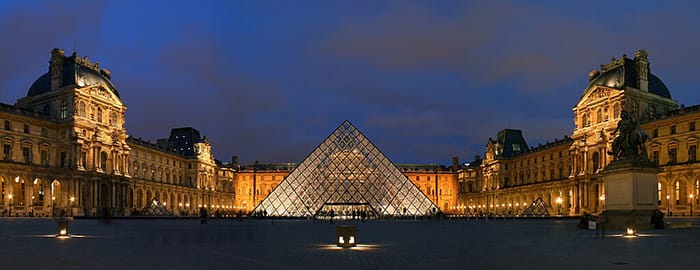
Le Grand Louvre
On being elected President of France in 1981, François Mitterrand arranged for the renovation of the Louvre Palace art museum. Based on what he had seen of Pei's work at the National Gallery in Washington DC, he selected the Chinese-American architect for the project, making Pei the first foreign architect to work on the historic site. Pei's design included the iconic glass pyramid (which he had previously wanted to use for the Kennedy Library in Boston) at the center of the pavilion, as well as modification to the interior, with a new centralized entrance, and a complex of additional floors with spaces for research, archives, and collection storage. Pei's designs were met initially with resistance from museum administrators and the French public. The architect later recalled that "the first year and a half was really hell. I couldn't walk the streets of Paris without people walking looking at me and saying, There you go again. What are you doing here? What are you doing to us? What are you doing to our great Louvre?"
Goldberger explains that Pei "argued that his glass pyramid was merely an updated version of a traditional form, and that his redesigned courtyard had been influenced by the geometric work of the French landscape architect Le Notre. It was rigorously rational, in other words, and in that sense classically French". On the recommendation of then-mayor of Paris, Jacques Chirac, Pei placed a scale model of the design in the courtyard for four days, during which time many who viewed it changed their minds and began to see it in a new light. During the construction process, several challenges arose, and Pei later stated, "After the Louvre [opened in March 1989] I thought no project would be too difficult".
Architecture journalist Paul Keskeys argues that "After nearly 25 years of existence, the glass and steel pyramid that serves as the Louvre's main entrance is one of I.M. Pei's seminal works. Not only was it a practical design, alleviating congestion in the galleries and allowing the museum to expand its collection, this landmark project has become synonymous with both the museum and the city of Paris. The crystalline structure, a perfect juxtaposition against the museum's French Renaissance style, matches the proportions of the famous Pyramids of Giza. Standing 22 meters high (72 feet) with 30-meter (98-meter) sloping sides, the pyramid invites visitors underground to explore this historic museum". The Louvre's former president-director, Jean-Luc Martinez, has called the Pyramid the "modern symbol of the museum" and a masterwork on the same plane as "the Mona Lisa, the Venus de Milo, and the Winged Victory of Samothrace".
Paris, France
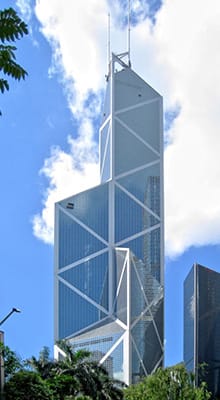
Bank of China Tower
In 1982, the governors of the Bank of China (the same bank that Pei's father, Tsuyee, had once governed) travelled to New York to meet with Tsuyee to request his permission to invite his son to design a new skyscraper for their headquarters in Hong Kong. Permission was granted, and Pei accepted, despite his negative experience working in China on the Fragrant Hill project. The resultant design was, for what Goldberger describes, as "a narrow 70-story composition [made necessary by the tiny plot of land designated for the site] of triangular and diamond shapes, built of glass and steel". Pei wanted the building to reflect "the aspirations of the Chinese people" in light of the 1984 signing the Sino-British Joint Declaration by the British and Chinese governments, which stated that the sovereignty of Hong Kong should be transferred to the People's Republic of China (PRC) on 1 July 1, 1997 (ending 156 years of British colonial rule). His design was also guided by the strict local wind-resistance regulations, and looked to the growth patterns of bamboo for inspiration in this regard.
While many Hong Kong residents criticized the tower for its failure to adhere to the principles of feng shui (a Chinese system of laws considered to govern spatial arrangement and orientation in relation to the flow of energy) international critics praised the design. For instance, architecture critic Steve Rose called the tower "one of the greatest, boldest, most distinctive skyscrapers ever designed, and a building that still looks as if it has been teleported in from the future". At the time of its completion in 1990, in fact, the building was, outside of the United States, the tallest in the world. Architecture journalist Dan Howarth has called the building "arguably the most striking on the Hong Kong skyline".
Hong Kong
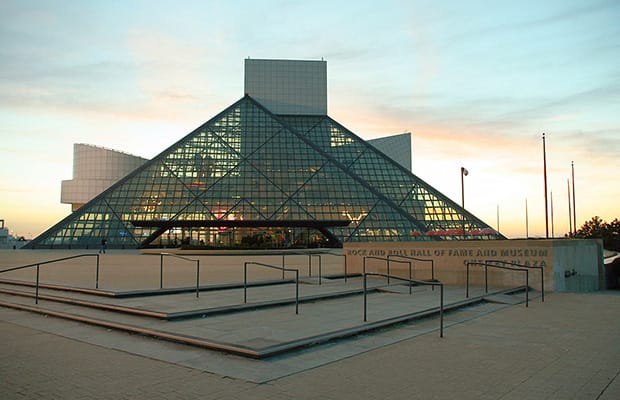
Rock and Roll Hall of Fame
Not a fan of rock music, when Pei was first approached to design the Rock and Roll Hall of Fame, he turned the offer down. The project's sponsors, however, pushed him to reconsider, as they wished for him to give the building an air of respectability. Pei eventually agreed, convinced, at least, that it would represent a unique challenge that allowed room for a significant exercise in creative thinking. Before beginning the design, he attended several rock concerts with Jann Wenner, the publisher of Rolling Stone magazine, where he gained inspiration from the "energy" of the genre.
The final design was "quintessential Pei", essentially an enormous glass pyramid (much like the Louvre) combined with other, asymmetrically-placed geometric elements, including a rectangular theatre space cantilevered over Lake Erie on one side, and a large drum on the other. The architect said he wished to convey "a sense of tumultuous youthful energy, rebelling, flailing about". Critical reception upon the museum's opening was neither superlative nor terrible: the New York Times said, simply, it was "a fine building"; architecture critic Herbert Muschamp called the design "saucy", although Pei himself said, rather candidly, that he was "quite disappointed" with the finished building.
Cleveland, Ohio
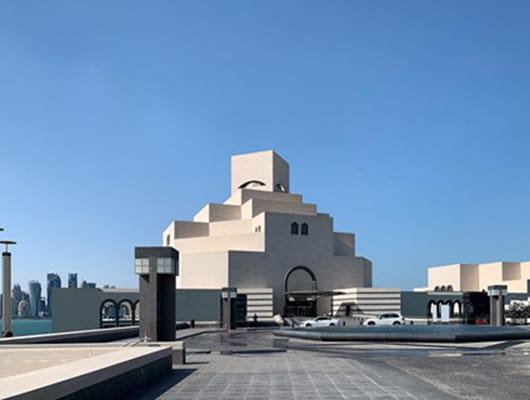
Museum of Islamic Art
Now semi-retired, Pei recorded a late career success with the Museum of Islamic Art in Doha, Qatar, today home of one of the world's greatest collections of Islamic art. Potential visitors to the museum are told: "Founded in 2008, the Museum of Islamic Art (MIA) was one of the first projects initiated by Qatar Museums. Designed by the renowned Chinese American architect I. M. Pei, MIA is a globally acclaimed museum that stands majestically on Doha's Corniche, with panoramic views of the city's waterfront. The museum showcases Qatar's world-class collections of Islamic art from the 7th to the 20th centuries". Goldberger explains that when taking on the project, "[Pei] admitted to knowing little about Islamic art [and] saw the Qatar commission as an opportunity to learn about a culture he did not claim to understand. He began his research by reading a biography of the Prophet Muhammad, and then commenced a tour of great Islamic architecture around the world". Indeed, as architecture journalist Nick Mafi has observed, "Perhaps Pei's greatest trait as an architect was his ability to absorb [new ideas]".
Pei, who cited the Ibn Tulun Mosque in Cairo (the biggest mosque on the African continent) as his chief influence, created a design featured a domed, five-story main building, connected to a two-story education wing by a large central courtyard. For the shape of the main building, explains architecture journalist Dan Howarth, he "used rigorous geometries found in traditional Islamic patterns". The exterior of the complex is cream/colored limestone, creating a curious play of light and shadow on the unique geometry of the design. Inside the atrium is a striking curved double staircase with a complementary curved metal chandelier. Architect Wahyu Pratomo has called the museum "the perfect building [...] from the moment you enter the premises, you only feel like going forward, and that movement forward eventually leads you to the image Qatar wants you to remember: the rising skyline of Doha", which is visible through enormous windows in each of the gallery spaces.
Doha, Qatar
Biography of I. M. Pei
Childhood
I. M. Pei was born Ieoh Ming Pei, in Canton (now Guangzhou), China. He was one of five children born into a family descended from the scholar-gentry class that dated back to the Ming dynasty. He was raised between Hong Kong and Suzhou, a city lying just to the west of Shanghai. His father, Tsuyee, was a banker and, for a time, Governor of the Central Bank of China; his mother, Lien Kwun, was an artist and an accomplished flautist. Ieoh Ming's name translates roughly as "to make an indelible mark" (a somewhat prophetic designation). As a child, Pei was very close to his mother, a devout Buddhist, and she often invited him (to the exclusion of his siblings) to accompany her on meditation retreats.
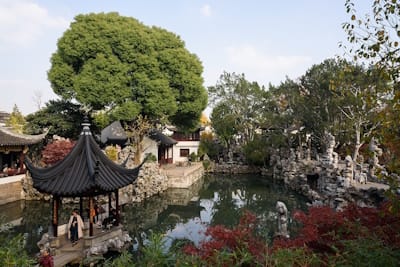
Young Pei took inspiration from his mother's interest in the arts (a passion not shared by his father), the lush gardens in and around their home in Suzhou, and from the diverse architecture found in and around nearby Shanghai ("the Paris of the East" as it was known). He was fascinated by the construction site of a twenty-five-story hotel, and said later, "That's when I knew I wanted to build". He attended St. Paul's College in Hong Kong, and St John's Middle School in Shanghai. At the latter, the study program, run by Anglican missionaries was severe, with only one half-day each month allowed for leisure pursuits. Pei used the time to play billiards, read the Bible and Charles Dickens novels (which helped him to gain a basic grasp of English), and watch Hollywood movies starring Buster Keaton and Charlie Chaplin.
Soon after Pei turned ten, his mother was diagnosed with cancer. He later recalled preparing the opium pipe that she had been prescribed to relieve her pain. She passed away just after his thirteenth birthday, and the loss affected him profoundly. With Pei's emotionally-distant father all consumed by his work, the five siblings were sent to live with extended family. (Pei's father later remarried and moved to New York, where he and his adult son would eventually reconnect.)
Education and Early Training
In 1935, Pei moved to the United States (traveling first by boat to San Francisco, and then by train to Philadelphia) to attend architecture school at the University of Pennsylvania (UPenn). Pei's decision to attend university in the U.S. was influenced by what he had seen in Hollywood films. He once said: "college life in the U.S. seemed to me to be mostly fun and games. Since I was too young to be serious, I wanted to be part of it. [Bing] Crosby's films in particular had a tremendous influence on my choosing the United States instead of England to pursue my education".
At UPenn, Pei soon became dissatisfied with the program's heavy emphasis on the ornamental Beaux-Arts style. He duly transferred to the architectural engineering program at the Massachusetts Institute of Technology (MIT). Although he found the curriculum just as old-fashioned, a professor, who recognized Pei's latent talents, persuaded him to persevere with his studies. He later stated "I certainly don't regret the time at MIT. There I learned the science and technique of building, which is just as essential to architecture [as the style]". He spent much of his downtime in the school's library, reading about modern architects, like Le Corbusier and Frank Lloyd Wright. In fact Le Corbusier visited MIT in 1935, and Pei had the good fortune to spend two study days with him, later calling them "the most important days in [my] architectural education".
Pei graduated in 1939, with his thesis titled "Standardized Propaganda Units for War Time and Peace Time China". His graduation coincided with the outbreak of WWII, and the second Sino-Japanese War (1937-45), and his father advised him against returning home. During the war, Pie became attached to a unit at the National Defense Research Committee that specialized in fusing bombs. As he explained, "They figured if you knew how to build buildings, you knew how to destroy them". During this period, Pei met Eileen Loo, also from a prominent Chinese family, and an art major at Wellesley College in Massachusetts. They married shortly after her graduation in 1942.
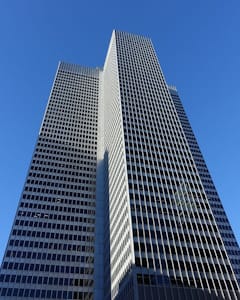
Between 1945 to 1948 Pei worked as an assistant professor at the Graduate School of Design at Harvard. He was also enrolled on Harvard's Graduate School of Design (GSD), where he studied under the German Modernist architect, and founder of the world-famous Bauhaus School, Walter Gropius. He noted with surprise that the student cohort was not particularly diverse, commenting, "It was me, a Chinese national, and the ladies". One of Pei's design projects was for an art museum in Shanghai, for which he aimed to blend Chinese aesthetics with non-traditional materials or styles. Gropius called it "the best thing done in [my] master class". Pei earned his MArch (advanced architecture degree) in 1946.
In 1948, Pei was recruited by real estate developer William Zeckendorf as director of the architectural division of his New York firm, Webb & Knapp. Projects Pei was involved in included the Mile High Center (1955) in Denver, the Hyde Park Redevelopment (1959) in Chicago, and the Place Ville-Marie (1965) in Montreal. The architectural critic, Paul Goldberger, writes, "Mr. Pei, refined and genteel, could not have been more different on the surface from the brash Zeckendorf. But the men shared a bold ambition, a love of French wine and a belief that architecture could improve cities". Pei later commented that while working on these urban projects, "I learned the process of development, and about the city as a living organism".
In New York, Pei, his wife, and their two young sons, moved into an apartment on Beekman Place in Manhattan. His first design to come to full fruition was for a two-story corporate building for Gulf Oil in Atlanta, Georgia, in 1949. Though it was demolished in February 2013 (save for the facade, incorporated into the apartment complex later built at the site), his design was well-received on its construction, with Architectural Forum praising Pei's use of marble for the exterior curtain wall. Says Goldberger, "the Zeckendorf years were a heady beginning for Mr. Pei's career" and he soon brought his former student, Henry Cobb, onto his team, as well as the young Ulrich Franzen.
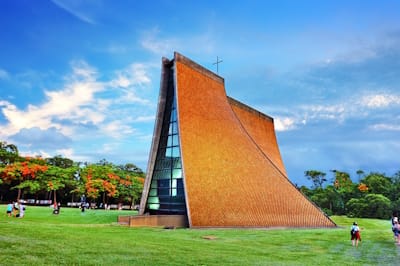
In 1954, Pei became a U.S. citizen. He started his own division, I. M. Pei & Associates, through which he began receiving commissions, such as the Luce Memorial Chapel in Taiwan, the Green Earth Sciences building at M.I.T., and a type of pentagonal control tower design for the Federal Aviation Agency (a design that was adopted by many other American airports). In 1960, Zeckendorf's firm began to have serious financial troubles. Pei opted to finally sever ties with the Zeckendorf practice altogether, launching his own firm, I. M. Pei & Partners, in 1966.
Mature Period
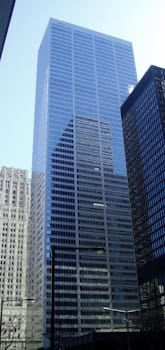
In the late 1960s, Pei was approached to lead a number of ambitious urban redevelopment projects. One of these, known as the Pei Plan, was for downtown Oklahoma City. Architectural critic Mark Byrnes writes, "Pei gave the Urban Action Foundation - a group of Oklahoma City power brokers - the city of tomorrow that they wanted. Gone would be the blighted older buildings and their modest, even unsavory, tenants. In their place would be soaring modern skyscrapers, a massive new convention center, and postcard-worthy public spaces, all filled up with productive, affluent locals and tourists". The city approved the Pei Plan in 1965, and set about demolishing 40 percent of the existing downtown (a total of 530 buildings including the historic Criterion Theater, the Mercantile and Pioneer buildings, and the limestone-and-marble Hales Building). Byrnes writes, "Even buildings not targeted under the Pei Plan were demolished, including the Lee-Huckins and the Biltmore hotels. But as the region sprawled [...] the retail and residential dreams from the Pei Plan never came to be".
Towards the end of the 1960s, Providence, Rhode Island, commissioned Pei to redesign Cathedral Square, and his new plaza opened there in 1972. However, a lack of city funds, as well as problems caused by rival building developments in the surrounding area, led to the plaza being labelled a "conspicuous failure" by the local media. However, a similar project led by Pei to revitalize downtown Augusta, Georgia, in the mid-1970s proved more successful.
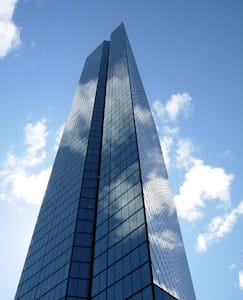
Pei was experiencing mixed fortunes at this stage in his career. The John Hancock Tower, at Copley Square in Boston was, when opened in 1976, the tallest building in New England. However, even during construction serious problems presented themselves. The building's facade was covered entirely in large reflective glass panels. But many of these fractured and crashed to the ground during a 1973 windstorm. Pei's team switched to smaller panels in order to correct the problem. This change incurred significant additional costs and led to conflicts between Hancock, I. M. Pei & Partners, and the glass manufacturers, Libbey-Owens-Ford, with several lawsuits and counter lawsuits issued by the warring parties. Following the Hancock Tower debacle (which pained Pei so greatly he refused to comment on it for several years), I. M. Pei & Partners saw a sharp dip in new commissions. Pei feared for a time that the practice may even have to close. But, as he later explained, "going through this trial toughened us. It helped to cement us as partners; we did not give up on each other".
In the mid-1970s, Pei returned to China for the first time since 1935. He undertook some design commissions, and presented a series of lectures in which he called upon Chinese architects to look to their country's tradition for inspiration rather than simply emulate international trends. Goldberger explains that in China, Pei "did not hesitate to criticize the banal, Soviet-influenced architecture that he saw, and he gave a talk in which he urged the Chinese to look back at their own traditions rather than 'slavishly following Eastern European patterns'".
1978 saw the doors open to the National Gallery East Building in Washington DC. A new home for the museums expanding collection of modern and contemporary art, Pei's design (chosen from 150 blueprints and models) harmonized with John Russell Pope's classicized West Building, (completed in 1941). It was a "return to form" for Pei, with the American architect Allan Greenberg, having been vocal in his criticism of early designs, declaring: "I was wrong! The building is a masterpiece". He followed in 1979 with another masterpiece, the John F. Kennedy Presidential Library and Museum, at Columbia Point Peninsula, overlooking the entrance to Boston Harbor. Standing as a tribute to the memory of the assassinated president, the library consists of a nine-story concrete tower which is adjoined to a glass-and-steel pavilion. Speaking of the pavilion, Pei said, "Its openness is the essence [...] in the reflective mood that the architecture seeks to engender [visitors] may find themselves thinking of John F. Kennedy in a different way. In the skyline of his city, in the distant horizons toward which he led us, in the canopy of space into which he launched us, visitors may experience revived hope and promise for the future".
Pei was awarded the Gold Medal from the American Institute of Architects (AIA), also in 1979, and confirmation of his rising star followed in 1983 when receiving the Pritzker Prize (known within the industry as the "Nobel Prize of architecture"). The jury citation for the Pritzker read: "Pei has given this century some of its most beautiful interior spaces and exterior forms [...] His versatility and skill in the use of materials approach the level of poetry". Pei used the prize money to establish a scholarship fund for Chinese students to study architecture in the United States with the stipulation they return to China to work.
Pei's reputation was briefly dented with the Jacob K. Javits Convention Center in New York City (1986) which was plagued by spiraling budget costs, administrative red tape, and construction problems. He and his team soldiered on, however, and soon found success in other projects. The most notable of these was the Louvre Pyramid (1989), a strikingly modern glass-and-metal structure situated in the main courtyard of the Louvre Palace in Paris. The main entrance to the world's most visited art museum, the Pyramid has since become a Parisian landmark. Also in 1989, Pei was the inaugural recipient of the Praemium Imperiale for Architecture, awarded by the Japan Art Association. Other successful commissions from this period included the Meyerson Symphony Center (1989), a facility in downtown Dallas, Texas, for cultural activities and events, and the home of the Dallas Symphony Orchestra, and The Gateway (1990), a soaring crystalline twin tower office complex that graces the Singapore skyline.
Labelling 1989 "the year of Pei", Goldberger notes that "As his firm grew in size and prestige - it would eventually employ 300 people - Mr. Pei seemed to become the quintessential New Yorker. He and his wife and family, which grew to include three sons and a daughter, moved to a townhouse on Sutton Place, facing the East River, where he remained for the rest of his life. He became an avid collector of postwar American art, and his townhouse contained works by Morris Louis, Jean Dubuffet, and Willem de Kooning; he also designed a weekend house for his family in Katonah, N.Y., in Westchester County, where he installed a 16-foot-high sculpture by [English abstract sculptor] Anthony Caro".
Late Period and Death
In 1990, Pei retired from full-time practice at his firm (renamed, Pei Cobb Freed & Partners) but remained involved in several prestige projects. He also continued to consult for the firm established by his sons, Li Chung and Chien Chung, Pei Partnership Architects.
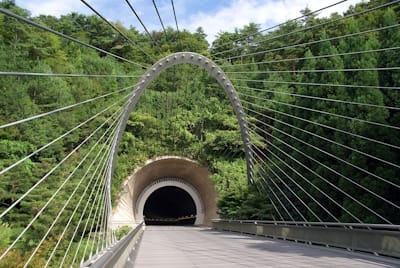
Pei undertook a number of important projects following his semi-retirement, many of them museums. In 1997, for example, he was approached by Japanese textile heiress Mihoko Koyama, and founder of the religious organization, Shinji Shumeikai, to design the Miho Museum in the city of Kōka (on the outskirts of Kyoto). The museum was to house hundreds of Asian and Western antiques, many of which relate to the history of the Silk Road (the name given to an expansive trade network connecting Eurasia and North Africa, via land and sea, lasting from around 114 BCE to 1450s CE, and which took its name from Chinese silk, a highly valued luxury commodity), as well as the Shinji Shumeikai headquarters. Pei's design included a suspension bridge leading to a circular entrance cut into the side of the mountain. Once inside the museum, visitors find themselves in a space illuminated by natural light via a glass roof, offset with a calming beige limestone wall. Pei's other late projects included an extension to the Deutsches Historisches Museum in Berlin (2003), the Musée d'art moderne Grand-Duc Jean in Luxembourg (2006), the Suzhou Museum in China (2006), the Museum of Islamic Art in Doha, Qatar (2008), and the Macao Science Center in China (2009).
In 2003, Pei accepted the Lifetime Achievement Award from the Cooper-Hewitt National Design Museum, but any happiness he would have felt at this latest distinction was dampened with the news that his eldest son, T'ing Chung, died after a prolonged illness. In 2010 his achievements were recognized again when he was honored with the Royal Institute of British Architects' Gold Medal. Pei's wife, Eileen, passed away in 2014, and the following year, a physical altercation with a home health aide led to Pei being briefly hospitalized (and a legal action to which the aide pleaded guilty).
On April 26, 2017, Pei celebrated his 100th birthday, at the Rainbow Room atop Rockefeller Center, in the company of several of the world's leading architects. The birthday cake was designed in the shape of one of his final projects, the Museum of Islamic Art. Pei passed away in his Manhattan apartment on May 16, 2019. He was survived by three adult children, seven grandchildren, and five great-grandchildren.
The Legacy of I. M. Pei
Referred to by the architectural writer Christopher Turner as "the last surviving modernist", Pei's buildings, from the Mesa Laboratory in Colorado; to the Louvre Pyramid in Paris; to the Rock and Roll Hall of Fame in Cleveland, have enriched the façade of many cities around the globe. A modernist he may have been, but Pei never lost sight of the need to respect local cultures and traditions. As architectural critic Paul Goldberger writes, "all of his work - from his commercial skyscrapers to his art museums - represented a careful balance of the cutting edge and the conservative. Mr. Pei remained a committed modernist, and while none of his buildings could ever be called old-fashioned or traditional, his particular brand of modernism - clean, reserved, sharp-edged and unapologetic in its use of simple geometries and its aspirations to monumentality - sometimes seemed to be a throwback, at least when compared with the latest architectural trends".
Another of the so-called "starchitects", the Spaniard Santiago Calatrava, said of his contemporary, "I saw him as an architect who carried the baton of modern architecture from one generation to the next, and the message he carried was heard all over the world. His architecture confronted the modern with the classic in an iconic fashion, and through these gestures he elevated a generation of architectural accomplishment to rival that of past masters in a way that many of his contemporaries could not". Indeed, his vision has been passed on to emerging architects, such as his compatriot Li Xioadong, who viewed Pei as "a true master of accommodating a complicated program with simple and clear form". The eminent British architect, Lord Norman Foster, said on his friend's passing, "[he] shaped contemporary practice in a major way [leaving] behind a formidable legacy that will continue to influence architects and designers for decades to come".
Influences and Connections

-
![Santiago Calatrava]() Santiago Calatrava
Santiago Calatrava - Henry Cobb
- Ulrich Franzen
- Lord Norman Foster
-
![Daniel Libeskind]() Daniel Libeskind
Daniel Libeskind -
![Norman Foster]() Norman Foster
Norman Foster - Li Xioadong
- Wang Shu
-
![Santiago Calatrava]() Santiago Calatrava
Santiago Calatrava - Henry Cobb
- Ulrich Franzen
- Lord Norman Foster
Useful Resources on I. M. Pei
- I.M. Pei: Architect Of Time, Place And PurposeOur PickBy Jill Rubalcaba
- I.M. Pei: A Profile in American ArchitectureOur PickBy Carter Wiseman
- Conversations with I.M. Pei: Light is the KeyOur PickBy Gero Von Boehm
- I M PeiBy Aileen Reid
- I.M. Pei: Complete WorksOur PickBy Philip Jodidio and Janet Adams Strong
- I. M. Pei: The Louvre PyramidBy Philip Jodidio
- The Architecture of I.M. PeiBy Carter Wiseman
- Architecture and Medicine: I.M. Pei Designs the Kirklin ClinicBy Aaron Betsky
 Ask The Art Story AI
Ask The Art Story AI












